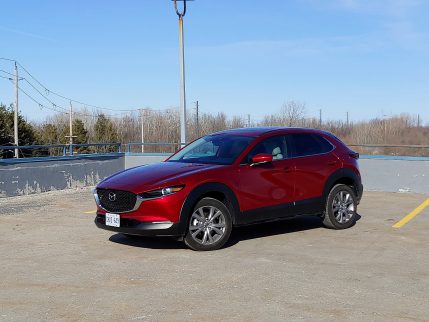by Chris Chase
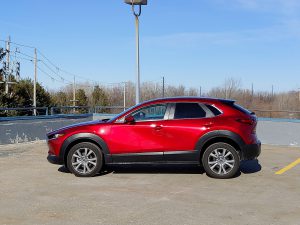 In 2008, BMW created a new breed of crossover SUV with its X6, a low-slung vehicle that the company dubbed a “sports activity coupe.” Coupe is the operative word, referring to the X6’s lower roof, which lends the car a dramatic look at the expense of interior space.
In 2008, BMW created a new breed of crossover SUV with its X6, a low-slung vehicle that the company dubbed a “sports activity coupe.” Coupe is the operative word, referring to the X6’s lower roof, which lends the car a dramatic look at the expense of interior space.
Other high-end brands followed BMW’s lead. Acura offered a short-lived competitor called the ZDX, and Mercedes-Benz now goes head-to-head with BMW with its own range of SUV coupes.
Now, Mazda is bringing SUV coupe design cues to a more affordable price point with its CX-30, an all-new model for 2020. Using the Mazda3 as its starting point, the CX-30 bolts a good-looking body combining car and SUV styling cues onto a raised chassis.
The result is less dramatic than any of the SUV coupes on offer by upscale brands, but with a $24,000 starting price, less than half what you’ll pay for small upscale models like the BMW X4 and Mercedes-Benz’s GLC Coupe.
Interior space and design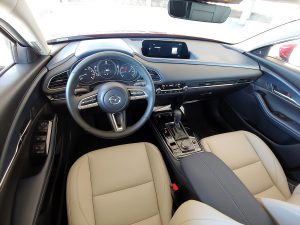
A lower roofline than the larger CX-5 crossover means the CX-30 has less headroom, but there’s more space inside than its appearance suggests. From the front seats, the main difference is a lower seating position, which makes for a visibility deficit. However, the view out to the rear is a bit better than in the Mazda3 Sport hatchback.
Back-seat riders will find the same good headroom with or without the CX-30’s sunroof, which is an option in GS trim and standard in GT. The issue for taller passengers is not so much a lack of headroom, but the fact that what’s available is tightly sandwiched between the sunroof and rear window, creating an oddly claustrophobic effect.
Mazda says the CX-30 has about 15 mm less front legroom than the 3 Sport, but 30 mm more rear-seat legroom. Behind the rear seat is a cargo area only marginally larger than that in the Mazda3 Sport, but it looks notably deeper.
The CX-30’s taller suspension also makes it a bit easier to get in and out of than the lower-riding Mazda3.
The CX-30’s secondary controls are straightforward and easy to use. Mazda’s infotainment system is one of our favourites because it lets you choose between the touch-sensitive screen and an easier-to-use console-mounted dial.
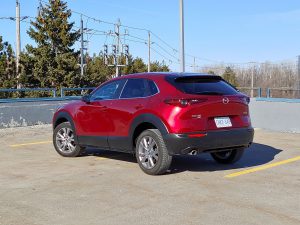 Performance and handling
Performance and handling
Mazda offers the CX-30 with a choice of 2.0L and 2.5L four-cylinder engines. The smaller motor is standard in the base GX trim, while GS and GT versions get the 2.5L.
In our GS test car, the 2.5L provided lively, if not exciting, performance with 186 hp and 186 lb-ft of torque. In our opinion, this is Mazda’s best engine, with linear power delivery. Mazda doesn’t offer its turbocharged 2.5L in the CX-30, but that’s okay: It may be more powerful, but it’s less fun to drive, because most of its power comes in the form of low-end torque.
The CX-30 is a sharp-handling small crossover, but if handling is one of your top requirements, the Mazda3 feels nimbler, thanks to its lower overall height and centre of gravity. The CX-30’s ride is firm without being uncomfortable on all but the worst road surfaces.
If you’re keen on a manual transmission, only the Mazda3 comes with one; the CX-30 is standard with a six-speed automatic. And if AWD traction is important, the Mazda3 can also be optioned with it in GS and GT trims with the 2.5L engine.
What safety features are included in the Mazda CX-30?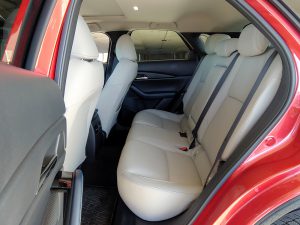
All CX-30 models come with blind spot monitoring and rear cross-traffic alert.
The GS trim we tested adds city-speed collision warning with automatic braking, radar cruise control, lane-departure warning with lane-keep assist, and driver attention alert.
The top-end GT model brings all those items, plus reverse-collision detection with automatic braking and traffic-sign recognition.
Fuel economy
My test car averaged 9.5 L/100 km in a week of city driving, just beating Mazda’s city estimate of 9.9 L/100 km; the CX-30’s highway rating with the 2.5L engine and AWD is 7.7 L/100 km.
You won’t save much fuel in a Mazda3 with the 2.5L and AWD; its estimates are 9.8/7.4 L/100 km (city/highway), and that’s with an optional cylinder deactivation system (which you can get in the CX-30 too, but only in the pricier GT trim).
Pricing, trim levels and options
Mazda CX-30 pricing starts at $23,950 in GX trim with its 2.0L engine, FWD and automatic transmission. Mid-range GS models come in at $26,650 (2.5L/FWD), and the GT model is a $33,950 car with the 2.5L and AWD.
There’s a $2,000 premium to add AWD to the CX-30 GS, taking our test car’s base price to $28,650. Mazda also fitted our tester with a $1,900 luxury package that bundles a sunroof, leatherette upholstery, a power driver’s seat with memory, and an auto-dimming rearview mirror. Finally, the Soul Red paint adds $450. All told, our CX-30 test car carried a $31,000 MSRP, before taxes and fees.
For comparison’s sake, a Mazda3 GT AWD starts at $31,500, and comes with real leather seating, navigation, a head-up display, adaptive headlights, passive keyless entry, and other niceties that weren’t included in our CX-30.
Conclusion
Our prediction is that the current generation of Mazda3 Sport hatchback will be the last, and that the CX-30 will effectively replace it in the brand’s lineup. Altogether, that’s not a bad thing, as the CX-30 is a good take on the crossover coupe concept: It drives well, looks good, and offers useful interior space.
If you test-drive the CX-30, our advice, for now, is to also take a spin in the Mazda3 Sport hatch. It’s a better value if you want all of Mazda’s high-tech kit, and if you’re an enthusiastic driver, it’s also more entertaining.
2020 Mazda CX-30 GS
Rating – 4.1/5
Vehicle category: Compact SUV/crossover
Engine: 2.5L four-cylinder gasoline; 186 hp, 186 lb-ft torque
Transmission: 6-speed automatic
Notable standard features (GX trim; MSRP: $23,950): LED headlights, 8.8-inch infotainment touchscreen, 7.0-inch gauge cluster display, electric parking brake, push-button start, heated front seats, blind spot monitoring, and rear cross traffic alert.
Notable standard features (GS trim w/ luxury package, as tested; MSRP: $31,000): Automatic on/off headlights with automatic high beams, heated side mirrors, rain-sensing wipers, automatic dual-zone climate control, heated/leather-trimmed steering wheel, radar cruise control, city-speed collision avoidance braking, lane departure warning/lane keep assist, and driver attention alert. Luxury package adds power sunroof, auto-dimming rearview mirror, leatherette upholstery, and 10-way power driver’s seat with memory.
Fuel economy, ratings (l/100km, city/highway): 9.9/7.7
Fuel economy, observed (l/100km): 9.5


